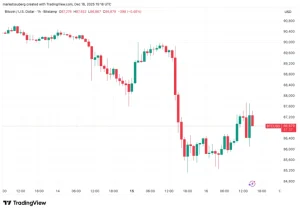Ethereum and Bitcoin Lose Momentum: Is the 2025 Crypto Rally Nearing Exhaustion?

Title: Ethereum and Bitcoin Lose Momentum: Is the 2025 Crypto Rally Nearing Exhaustion?
Summary
After months of steady gains that reignited optimism across digital markets, both Bitcoin and Ethereum have begun to show signs of fatigue. Bitcoin’s price has slipped below key technical thresholds, while Ethereum has followed suit with a notable decline in trading volumes. The market’s retreat has raised questions over whether the much-anticipated 2025 crypto rally is losing momentum. Analysts point to a combination of macroeconomic tightening, profit-taking, and declining liquidity as primary factors behind the slowdown. The correction may signal a transitional phase — a pause before the next phase of sustainable growth or a deeper recalibration in investor sentiment.
A Shift in Market Sentiment
The cryptocurrency market, which entered 2025 with renewed bullish enthusiasm, appears to be hitting a temporary ceiling. Bitcoin, the world’s largest digital asset, has declined modestly after months of steady appreciation, while Ethereum — its closest rival — has faced comparable downward pressure.
The pullback comes as investors reassess risk amid fluctuating global liquidity conditions and central banks’ cautious stance on monetary easing. Market observers note that digital assets are once again mirroring traditional risk assets, moving in sync with equities and commodities rather than operating as independent inflation hedges. This correlation suggests that investor confidence in the crypto rally may be waning in the short term.
Macro Headwinds Weigh on Digital Assets
One of the major factors driving the current downturn is tightening global financial policy. Central banks, particularly in the United States and Europe, have signaled a slower pace of interest rate cuts than previously expected. This has led to a contraction in liquidity — a key driver of speculative investments like cryptocurrencies.
Furthermore, the strengthening of major fiat currencies has also dampened enthusiasm for riskier assets. The rupee’s relative stability against the dollar, for instance, has reduced domestic demand for Bitcoin as a hedge against currency depreciation. Meanwhile, institutional inflows have cooled, suggesting a temporary pause in large-scale investment momentum.
Despite this, long-term believers in blockchain technology argue that short-term volatility is part of the market’s natural cycle, not a signal of structural weakness.
Ethereum’s Underperformance and Network Dynamics
Ethereum’s recent decline extends beyond market sentiment; it also reflects structural shifts within its ecosystem. Transaction volumes and decentralized finance (DeFi) activity have plateaued, indicating a slowdown in user engagement. Additionally, Ethereum’s gas fees — though lower than in past cycles — remain an obstacle for broader adoption.
However, ongoing upgrades to the Ethereum network continue to attract developer interest, with many viewing these innovations as the foundation for the next growth phase. Analysts suggest that Ethereum’s long-term value will depend on its ability to expand real-world use cases, from tokenized assets to enterprise blockchain applications.
In contrast, Bitcoin’s value remains primarily narrative-driven, dependent on its perception as “digital gold” rather than on utility-based growth.
Profit-Taking and Market Liquidity
After months of gains, profit-taking among short-term traders has accelerated. Many investors who entered the market during the previous rally are choosing to lock in returns, leading to short-term price pressure.
Liquidity in crypto exchanges has also tightened. Lower trading volumes indicate that institutional investors may be waiting for clearer macroeconomic signals before increasing exposure. The absence of major catalysts — such as regulatory breakthroughs, ETF approvals, or new blockchain innovations — has left the market searching for direction.
Nonetheless, seasoned investors view these pullbacks as healthy corrections that consolidate gains and shake out excessive speculation, paving the way for more sustainable future growth.
Long-Term Outlook: Correction or Consolidation?
Despite current headwinds, the broader outlook for cryptocurrency remains cautiously optimistic. Analysts emphasize that the ongoing correction does not necessarily signal the end of the rally but may represent a cooling phase within a longer bull cycle.
Bitcoin’s halving earlier this year — an event that historically precedes significant price surges — continues to provide long-term support. Similarly, the growing institutional adoption of digital assets and blockchain technology offers a foundation for renewed investor confidence.
However, the road ahead will depend heavily on macroeconomic stability, regulatory clarity, and technological advancement across blockchain ecosystems.
Investor Strategy in a Volatile Market
For investors, the current environment underscores the importance of strategy and discipline. Experts recommend focusing on fundamental projects with proven utility rather than short-term speculation. Diversification — across both crypto and traditional assets — remains essential to mitigating volatility risks.
Moreover, as the market matures, long-term investment horizons are expected to reward patience. While Bitcoin and Ethereum may face temporary price fatigue, their fundamental drivers — scarcity, decentralization, and innovation — remain intact.
In the evolving digital economy, short-term setbacks often serve as precursors to larger structural gains.
Conclusion: A Pause, Not a Collapse
The recent downturn in Bitcoin and Ethereum prices represents a pause in the broader 2025 crypto rally, not its demise. Market fatigue, liquidity constraints, and macroeconomic uncertainty have collectively triggered a short-term correction. Yet, the fundamental forces propelling digital assets — innovation, decentralization, and growing institutional legitimacy — remain powerful.
As investors navigate this period of recalibration, the question is not whether the crypto rally has ended, but how long this pause will last before the next wave of capital re-enters the digital frontier. The market may be cooling, but its long-term trajectory continues to point toward structural evolution and enduring relevance.




